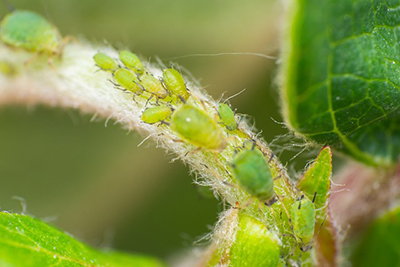The Wave Crew Wave Petunias | Cool Wave Pansies

When you're an avid Wave Petunia gardener, you encounter many obstacles throughout the gardening season. From cold spells to drought to disease and pests. As the challenges arise, you and your plants battle to come out on top and in full-bloom.
One of the pests that seem to really enjoy suckling on your beautiful Wave Petunias is Aphids. These soft-bodied insects are very common to yards and gardens, and while in most cases they cause very little health risks to your plants, you can't deny that they really can gross you out and make your flower experience less enjoyable.
To help manage your garden pests, the Wave Petunia Team always highly recommends finding helpful regional advice through your local University Extension office. Those offices usually have guides, recommendations and other resources to help you be successful. Find your nearby office through this USDA link.
But back to Aphids on your petunias. What are some basic tips to get them to take a hike.
Watch the Weeds
Start by making sure the Aphids have very little food so that they don't overstay their welcome in your garden. Aphids find sowthistle and mustard-type weeds very appetizing and attractive, so a steady pace of removing as many weeds from your garden as possible can make their gathering less of a feast.
Blast 'Em
Aphids are not strong insects, and according to the University of Minnesota, "even a good rainstrom can knock them off. You may notice more aphids in seasons with lighter rain." Use the high-stream setting on your garden hose and blast your petunia plants to dislodge them. Be sure to get the undersides, too, as that's where they often hide.
Call for Reinforcements
Introducing predatory insects into your garden is another way to keep Aphid populations down. By planting flowers that also attract ladybugs and lacewing beetles to your garden, you're inviting a natural predator to the feast. Many independent garden stores or online mail-order catalogs also sell predatory bugs (parasitic wasps and syrphid fly larvae). Release them and let them go to work!
Use Pesticides
We place this tip last on our list because we feel adding insecticides to your garden should generally be a last-resort. And when we do list options, we try to choose the most natural and least invasive possible. With that said, Neem (azadirachtin) is a plant-based insecticide that will discourage Aphid feeding. It won't kill them outright, but they will eventually find your petunias unappetizing. They'll stop eating and move on to other food or eventually they'll die. Remember to spray the undersides of the leaves as well as the top. Insecticidal soap, horticultural oil and pyrethrins can also be effective at controlling Aphids.
The University of Minnesota offers this caution when choosing to use any pesticides in your garden: "Read all pesticide label directions very carefully before buying and again before using to ensure proper application. Be sure that the label specifies it can be used on the specific plant you wish to treat. The label is the final authority on how you may legally use any pesticide.
"Whenever using any pesticide, including low impact, natural or organic pesticides, follow all label directions and use standard pesticide safety practices for transporting, storing, mixing, applying and disposing of pesticides to protect yourself, your neighbors and the environment.
We hope these quick tips on Aphids help you enjoy your Wave Petunia garden to the fullest! Got any other helpful tips to share? Comments are always welcome below.